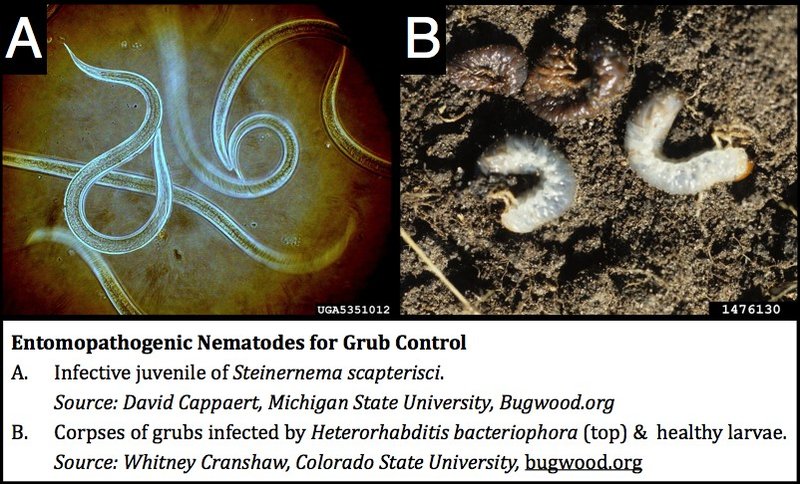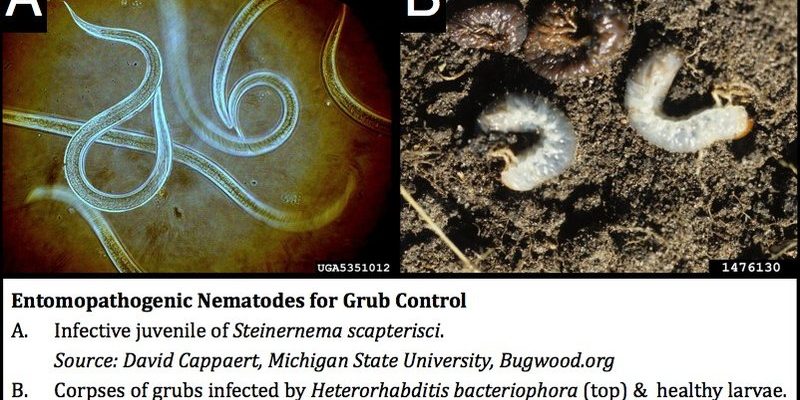
So, what exactly are these nematodes? Picture them as microscopic worms that thrive on the very pests causing trouble in your garden. By introducing nematodes to your soil, you’re inviting in a natural predator that takes care of grubs while keeping your environment safe. Let’s dig deeper into how these little wonders work and why they might be the perfect solution for your grub worm woes.
What Are Grub Worms?
Grub worms, or grubs, are the larvae of various beetles, such as June bugs and Japanese beetles. They look like C-shaped, white worms with a soft body and a brown head. Typically, they dwell in the soil, munching on grass and plant roots. As a result, they can cause significant damage to your lawn or garden if not controlled. The signs of their presence are pretty noticeable—yellowing grass, patchy areas, and sometimes even a lawn that pulls up easily, like a carpet coming loose.
You might be wondering how they get into your garden in the first place. They lay eggs in the soil during the summer months, and when those eggs hatch, that’s when the real trouble starts. The grubs begin feasting on grass roots, leading to the brown patches we dread. Identifying grub infestations early is crucial for effective control, and that’s where nematodes come into play.
Introducing Nematodes: Nature’s Pest Control
Nematodes are microscopic worms that live in the soil. They can be beneficial or harmful, but in this case, we’re talking about the beneficial kind. These tiny creatures are natural predators of many garden pests, including grubs. When you introduce nematodes to your garden, they seek out and infect the grubs, ultimately leading to the grubs’ demise. It’s a natural form of pest control that fits perfectly into any eco-friendly gardening approach.
The best part? Nematodes don’t harm plants, pets, or humans, making them a safe choice for pest management. By using nematodes, you’re tapping into a longstanding ecological principle: maintaining balance through natural predators. This not only helps eliminate grubs but also promotes a healthier garden ecosystem overall.
How Do Nematodes Work?
Now, let’s break down the process of how these nematodes do their magic. When you apply nematodes to the soil, they start hunting for grubs. Once they locate a grub, they enter its body through natural openings. After this, the nematodes release bacteria that multiply and cause the grub to die. In a nutshell, they turn the grub into a cozy home, where the nematodes can reproduce and continue their pest-fighting mission.
It’s fascinating how this process works, isn’t it? The nematodes reproduce inside the host, and then they can spread to find more grubs. It’s like they’re on a mission to clear your garden of pests. In a single application, they can last for weeks or even months, continuing their work even after the initial infection.
Choosing the Right Nematodes for Your Garden
When it comes to nematodes, not all are created equal. There are different species, each targeting specific pests. For grubs, you’d typically look for either Heterorhabditis bacteriophora or Steinernema carpocapsae. Both species have shown effectiveness against various grub types.
You can find nematodes at garden centers or online. Before you buy, check that they’re suitable for your specific grub problem. It’s important to read the product labels to ensure you’re getting the right type. Always look for fresh nematodes, as their effectiveness decreases over time.
Here’s a little pro tip: consider the timing of your application. The best time to introduce nematodes is when soil temperatures are between 55°F and 85°F. This temperature range is when grubs are most active, making it the perfect opportunity for nematodes to do their job.
How to Apply Nematodes
Applying nematodes is surprisingly simple, and you can do it yourself! Here’s a step-by-step guide to help you out:
1. **Prepare Your Soil**: Water your lawn or garden a day before applying nematodes. This helps the nematodes move through the soil more easily.
2. **Mix the Nematodes**: Follow the instructions on the packaging for mixing them with water. It’s usually a matter of dissolving them in water to create a slurry.
3. **Apply Evenly**: Use a sprayer or watering can to distribute the nematodes evenly over the affected areas. Aim for moist soil, as nematodes thrive in damp conditions.
4. **Water Again**: After application, water the area lightly to help the nematodes settle into the soil and locate grubs.
And that’s it! You’ve just invited a tiny army into your garden, ready to tackle those pesky grubs.
Benefits of Using Nematodes
There are plenty of reasons to consider using nematodes as a biological control for grub worms. First and foremost, they’re effective. Many gardeners report significant reductions in grub populations after applying nematodes.
Here’s an interesting fact: using nematodes can lead to healthier soil. By promoting natural predators, you’re supporting a balanced ecosystem, which is essential for maintaining plant health. Furthermore, they’re environmentally friendly, so you won’t have to worry about chemicals leaching into your groundwater or affecting beneficial insects.
Nematodes also offer a long-term solution. Once established, they can remain in your garden, helping to prevent future grub infestations. Instead of relying on chemical treatments that may need repeated applications, introducing nematodes could save you time and effort in the long run.
Considerations and Precautions
While nematodes are generally safe and effective, there are a few things to keep in mind. Make sure you follow the application instructions carefully; the wrong dosage can lead to ineffective results. Environmental conditions can also impact their success. High temperatures or dry spells can diminish their effectiveness, so timing is crucial.
Another point to consider is the presence of other beneficial insects. If you’re using nematodes as a targeted approach for grubs, be aware that they might have some impact on other soil organisms as well. However, most beneficial insects tend to coexist with nematodes comfortably.
Lastly, remember to monitor the results after application. If you still see signs of grub damage, it might be worth consulting with a local gardening expert for further advice. Sometimes, it can take a little trial and error to find the best pest management strategy for your specific garden.
In conclusion, introducing nematodes into your garden can be a game-changer for battling grub worms. They offer an eco-friendly solution that’s easy to implement and can lead to a healthier garden over time. So, next time you face this common garden problem, consider letting the little heroes of the soil do their work for you!

